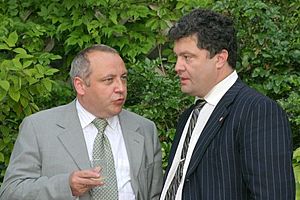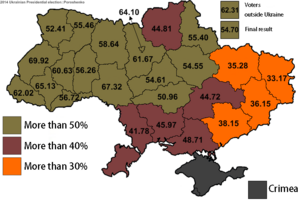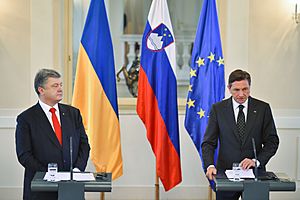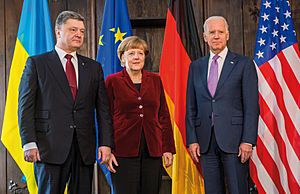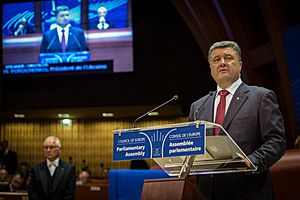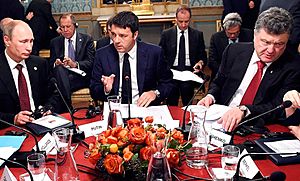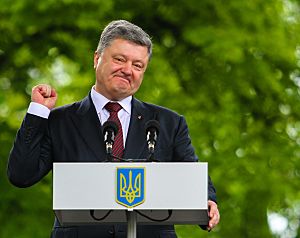Petro Poroshenko facts for kids
Quick facts for kids
Petro Poroshenko
|
|
|---|---|
|
Петро Порошенко
|
|

Official portrait, 2014
|
|
| 5th President of Ukraine | |
| In office 7 June 2014 – 20 May 2019 |
|
| Prime Minister | |
| Preceded by | Oleksandr Turchynov (acting) |
| Succeeded by | Volodymyr Zelenskyy |
| Minister of Trade and Economic Development | |
| In office 13 March 2012 – 4 December 2012 |
|
| Prime Minister | Mykola Azarov |
| Preceded by | Andriy Klyuyev |
| Succeeded by | Ihor Prasolov |
| Minister of Foreign Affairs | |
| In office 9 October 2009 – 11 March 2010 |
|
| Prime Minister |
|
| Preceded by | Volodymyr Khandohiy |
| Succeeded by | Kostyantyn Gryshchenko |
| Secretary of the National Security and Defense Council |
|
| In office 8 February 2005 – 8 September 2005 |
|
| President | Viktor Yushchenko |
| Preceded by | Volodymyr Radchenko |
| Succeeded by | Anatoliy Kinakh |
| People's Deputy of Ukraine | |
| Assumed office 29 August 2019 |
|
| Constituency | European Solidarity, No. 1 |
| In office 12 December 2012 – 3 June 2014 |
|
| Succeeded by | Oleksii Poroshenko |
| Constituency | Vinnytsia Oblast, No. 12 |
| In office 12 May 1998 – 15 June 2007 |
|
| Constituency |
|
| Personal details | |
| Born | 26 September 1965 Bolhrad, Ukrainian SSR, Soviet Union (now Bolhrad, Odesa Oblast, Ukraine) |
| Political party | European Solidarity (2019–present) |
| Other political affiliations |
|
| Spouse | |
| Children | 4, including Oleksii |
| Residences | Kozyn, Kyiv Oblast |
| Alma mater | Taras Shevchenko National University |
| Occupation | Businessman and politician |
| Signature |  |
| Military service | |
| Allegiance |
|
| Branch/service |
|
| Years of service |
|
| Rank | Major |
| Battles/wars |
|
Petro Oleksiiovych Poroshenko (born 26 September 1965) is a Ukrainian politician. He was the fifth president of Ukraine from 2014 to 2019. People sometimes call Poroshenko the "Chocolate King." This is because he owns Roshen, a very large candy company in Ukraine. In 2012, Forbes magazine listed him as a billionaire.
In April 2024, Poroshenko said he plans to run in the next Ukrainian presidential election.
Contents
Early life and education
Petro Poroshenko was born on September 26, 1965, in Bolhrad, Ukraine. His father, Oleksiy Poroshenko, was an engineer. He managed several factories in the Ukrainian SSR. His mother, Yevhenia Serhiyivna Hryhorchuk, was an accountant.
Poroshenko spent his childhood in Tighina (now Bender). His father was in charge of a machine-building plant there. Petro learned to speak Romanian during this time.
When he was young, Poroshenko practiced judo and sambo. He was a skilled athlete in these sports.
In 1989, Poroshenko finished his studies at the Taras Shevchenko National University of Kyiv. He earned a degree in economics.
In 1984, Poroshenko married Maryna Perevedentseva. She was a medical student. Their first son, Oleksiy, was born in 1985. They later had three more children.
After university, Poroshenko worked as an assistant in the international economic relations department. While still a student, he started a company. It helped with foreign trade contracts. Later, he began supplying cocoa beans to candy factories in the Soviet Union.
Business career
In 1993, Petro Poroshenko and his father, Oleksiy, started a company called UkrPromInvest. This company focused on making candy and cars.
Between 1996 and 1998, UkrPromInvest took control of several state-owned candy factories. These factories became part of the Roshen group. Roshen grew to be the largest candy maker in Ukraine. Poroshenko's businesses also included car and bus factories. He owned the Kuznia na Rybalskomu shipyard and the 5 Kanal television channel. He also had other businesses in Ukraine.
When he became President of Ukraine, Poroshenko said he gave up managing his businesses. He put them into a special arrangement called a blind trust in 2016.
Associated businesses
Many businesses were once part of the Ukrprominvest group. Poroshenko led this group from 1993 to 1998. The group was later split up in 2012.
- Roshen group (candy making)
- 5 Kanal and Priamyi television channels
- Kuznia na Rybalskomu shipyard in Kyiv
- International Invest Bank
- Ukrprominvest-Agro (farming businesses)
Early political career
Poroshenko first became a member of the Verkhovna Rada (Ukraine's Parliament) in 1998. He represented the 12th district. He was first part of the United Social Democratic Party of Ukraine (SDPU). In 2000, he left this party. He then created his own party, called the Party of Ukraine's Solidarity.
In 2001, Poroshenko helped create the Party of Regions. His Party of Ukraine's Solidarity joined the Party of Regions. After that, Poroshenko started a new party with a similar name, "Solidarity."
Secretary of the National Security and Defense Council
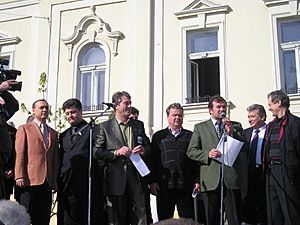
In December 2001, Poroshenko joined the opposition. He became the campaign leader for Viktor Yushchenko's Our Ukraine Bloc. After the parliamentary elections in March 2002, Poroshenko won a seat in parliament. He led the parliamentary budget committee.
Poroshenko was a close friend of Yushchenko. Yushchenko is the godfather of Poroshenko's daughters. Poroshenko was a wealthy supporter of Yushchenko. He was also a main financial backer of Our Ukraine and the Orange Revolution. After Yushchenko won the presidential elections in 2004, Poroshenko was made Secretary of the National Security and Defense Council.
In September 2005, there were disagreements between Poroshenko and Prime Minister Yulia Tymoshenko. As a result, Yushchenko removed his entire government, including Poroshenko and Tymoshenko.
In the March 2006 parliamentary election, Poroshenko was re-elected to the Ukrainian parliament. He was supported by the Our Ukraine group. He became the head of the parliamentary Committee on Finance and Banking.
Poroshenko did not run in the September 2007 parliamentary election. In February 2007, he became the head of the Council of Ukraine's National Bank. He was a board member of the National Bank of Ukraine from 1999 to 2012.
Foreign Minister and Minister of Trade
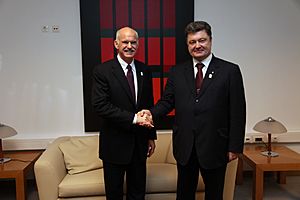
Ukrainian President Yushchenko chose Poroshenko to be the Foreign Minister on October 7, 2009. Ukraine's parliament, the Verkhovna Rada, approved him on October 9, 2009. On October 12, 2009, President Yushchenko also put Poroshenko back on the National Security and Defense Council.
Poroshenko supported Ukraine joining NATO. He said that NATO membership should not be the only goal. He was removed as foreign minister on March 11, 2010. However, President Viktor Yanukovych said he hoped to work with him again.
In February 2012, Poroshenko was named the new Minister of Trade and Economic Development. President Yanukovych officially appointed him on March 23, 2012. In the same month, he left his role as head of the Council of Ukraine's National Bank.
Poroshenko stated that he became Minister of Trade and Economic Development to help bring Ukraine closer to the EU.
Return to parliament
Poroshenko returned to the Verkhovna Rada (parliament) after the 2012 Ukrainian parliamentary election. He won as an independent candidate in the Vinnytsia Oblast region. He did not join any political group in parliament. Instead, he became a member of the committee on European Integration.
In 2013, his "Solidarity" party's registration was canceled. This was because it had not taken part in any elections for over 10 years. Poroshenko then started a new group called the "All-Ukrainian Union Solidarity."
2014 Ukrainian revolution
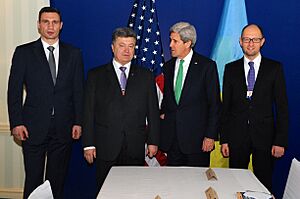
Poroshenko actively supported the Euromaidan protests. These protests happened between November 2013 and February 2014. His support made him more popular. His television channel, Channel 5, played a big role in showing the protests.
Poroshenko did not join the new government formed after the revolution.
2014 presidential campaign
After the 2014 Ukrainian revolution, new presidential elections were set for May 25, 2014. In polls from March 2014, Poroshenko had the most support. On March 29, he announced he would run for president. At the same time, Vitali Klitschko decided not to run and supported Poroshenko.
On April 2, Poroshenko said, "If I am elected, I will be honest and sell the Roshen Group." He also said he would not sell his 5 Kanal television channel.
On May 29, the Central Election Commission of Ukraine announced that Poroshenko had won the election. He received 54.7% of the votes.
Presidency (2014–2019)

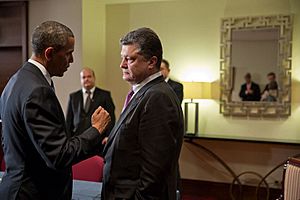
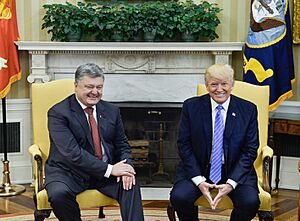
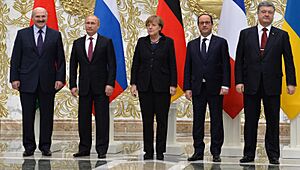
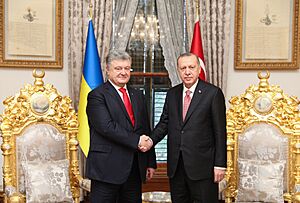
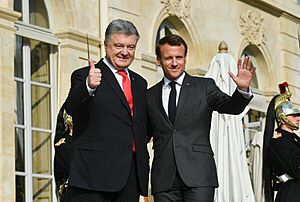
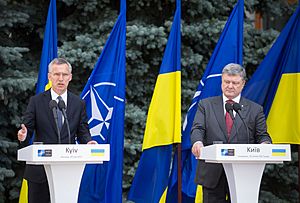
After winning the election on May 25, 2014, Poroshenko said his first trip as president would be to Donbas. This region had armed pro-Russian rebels. He also promised to continue military actions to stop the rebellion. He said the "anti-terrorist operation" should last "hours," not months.
As president-elect, Poroshenko promised to get Crimea back. Crimea was taken by Russia in March 2014. He also said he would hold new parliamentary elections in 2014.
Inauguration
Poroshenko became president in the Verkhovna Rada (parliament) on June 7, 2014. In his speech, he said that Ukraine would not give up Crimea. He also emphasized the unity of Ukraine. He promised to offer amnesty (forgiveness) to those involved in the conflict who had not committed serious crimes. But he added, "Talking to gangsters and killers is not our path." He also called for early regional elections in Eastern Ukraine.
Poroshenko said he would sign the economic part of the Ukraine–European Union Association Agreement. He saw this as the first step toward Ukraine joining the EU. He stated that Ukrainian would be the only state language. However, he also spoke of protecting the development of Russian and other languages in Ukraine. Part of his speech was in Russian.
Domestic policy
Peace plan for Eastern Ukraine
When Poroshenko became president, armed pro-Russian rebels had declared independence in parts of Donbas. These areas were called the Donetsk People's Republic and Luhansk People's Republic. Most countries did not recognize them as real states. Poroshenko started a "peace" plan. It included a cease-fire with the rebels. It also aimed to create a safe path for civilians. Poroshenko warned he had a "Plan B" if his first peace plan failed.
Decentralization of power
In mid-June, Poroshenko began changing Ukraine's constitution. The goal was to make Ukraine's government more decentralized. This means giving more power to local areas. Poroshenko said this was a key part of his peace plan. He suggested changing how Ukraine's regions, districts, and communities are organized.
He proposed that local governments could decide the status of the Russian language. They could also decide about other minority languages in their areas. However, Ukrainian would remain the only official state language.
Poroshenko also suggested creating presidential representatives. These people would make sure the constitution and laws are followed. They would also ensure human rights are protected in different regions.
He often spoke against federalization. This means dividing the country into more independent states. He did not try to increase his own presidential powers.
A draft law for decentralization was proposed on July 1, 2015. It gave local authorities the right to control how their tax money was spent. This law did not give special independent status to Donbas. However, it did give the region some self-rule for three years.
Decommunization
On May 15, 2015, Poroshenko signed a law. This law started a six-month period to remove communist monuments. It also required renaming streets and places with communist names. This process is called decommunization.
Language
In 2016, a new rule began for Ukrainian radio stations. They had to play a certain amount of Ukrainian-language songs each day. The law also required TV and radio to have 60% of their news and analysis programs in Ukrainian.
On September 25, 2017, President Poroshenko signed a new education law. This law states that the Ukrainian language is the main language for teaching at all levels. However, one or more subjects can be taught in other languages. These include English or other official languages of the European Union. The law allowed a three-year period for schools to fully adapt. In February 2018, this period was extended until 2023.
This law received some criticism. Officials from Hungary, Romania, and Russia expressed concerns.
On May 15, 2019, Poroshenko signed another law. This law was about how the Ukrainian language works as the official state language.
In the 2019 Ukrainian presidential election, Poroshenko lost to Volodymyr Zelenskyy.
Personal life
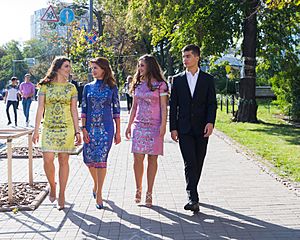
Poroshenko has been married to Maryna Perevedentseva since 1984. She is a cardiologist. They have four children: Oleksii (born 1985), twins Yevheniia and Oleksandra (born 2000), and Mykhailo (born 2001). Oleksii became a member of parliament in November 2014. Poroshenko became a grandfather on the day he became president, June 7, 2014.
His wife, Maryna, is very active in the Petro Poroshenko Charity Foundation.

Poroshenko is a member of the Ukrainian Orthodox Church. Besides his native Ukrainian, he speaks Russian, English, and Romanian.
Poroshenko has diabetes.
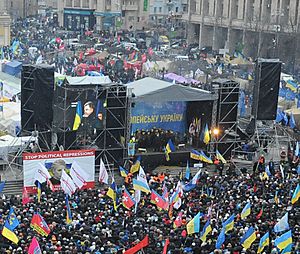
Awards
 Ukraine: Order of Merit
Ukraine: Order of Merit Moldova: Order of the Republic
Moldova: Order of the Republic Poland: Order of the White Eagle
Poland: Order of the White Eagle Spain: Order of Civil Merit
Spain: Order of Civil Merit Ukraine: Medal of winner of Ukraine State Prize in Science and Technology
Ukraine: Medal of winner of Ukraine State Prize in Science and Technology Saudi Arabia: Order of King Abdulaziz
Saudi Arabia: Order of King Abdulaziz Lithuania: Grand Cross of the Order of Vytautas the Great
Lithuania: Grand Cross of the Order of Vytautas the Great Ecumenical Patriarchate of Constantinople: cross of Panagia Pammakaristos (5 January 2019)
Ecumenical Patriarchate of Constantinople: cross of Panagia Pammakaristos (5 January 2019)- Orthodox Church of Ukraine: Order of St. Andrew Pervozvannyi (meaning "The First-Called")
Images for kids
See also
 In Spanish: Petró Poroshenko para niños
In Spanish: Petró Poroshenko para niños


